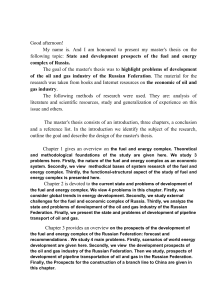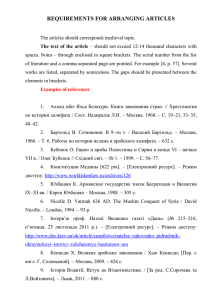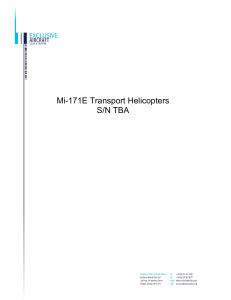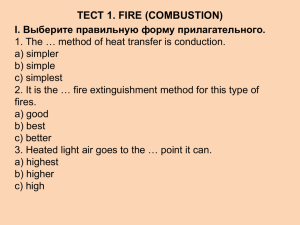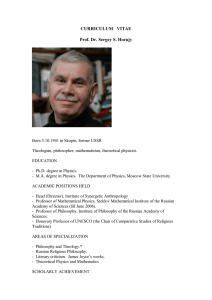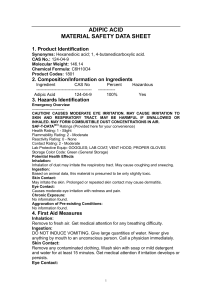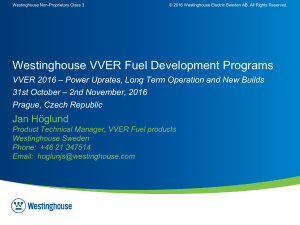Aleksander Golubenko, Valentin Mogila, Elena Nozhenko, About Problem Kinetic Description of Combustion Process in Fuel Ozonization in Diesel Engine on Transport Vehicles, TRANSPORT PROBLEMS. PROBLEMY TRANSPORTU v. 5(2), pp. 31-36, 2010
реклама
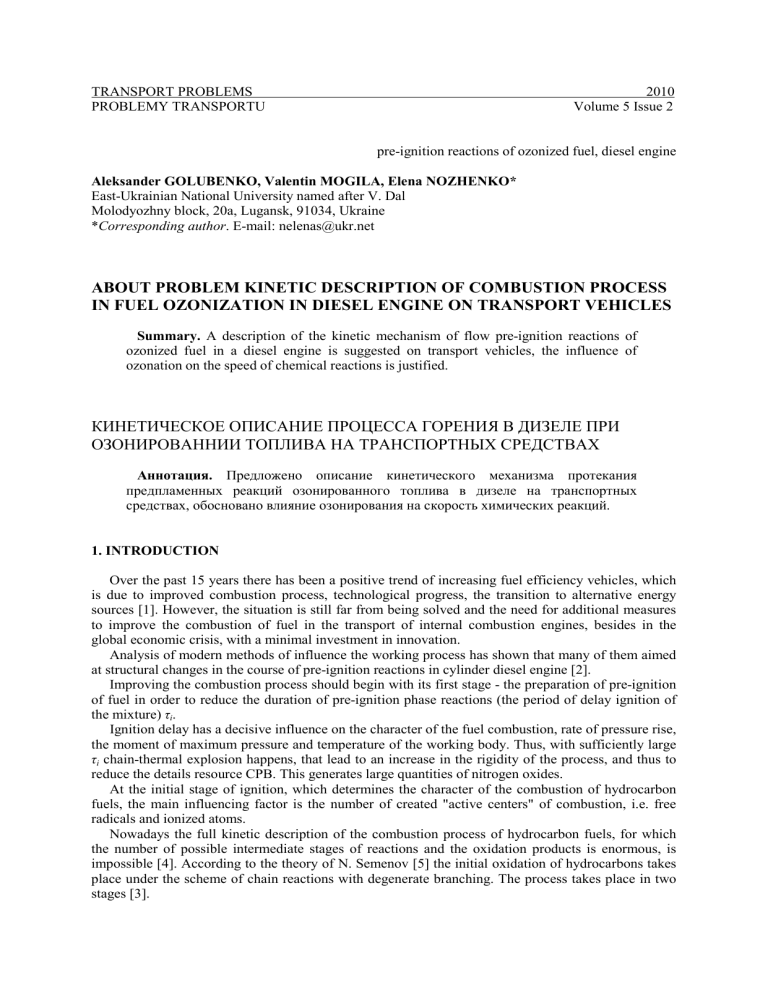
TRANSPORT PROBLEMS PROBLEMY TRANSPORTU 2010 Volume 5 Issue 2 pre-ignition reactions of ozonized fuel, diesel engine Aleksander GOLUBENKO, Valentin MOGILA, Elena NOZHENKO* East-Ukrainian National University named after V. Dal Molodyozhny bloсk, 20a, Lugansk, 91034, Ukraine *Corresponding author. E-mail: [email protected] ABOUT PROBLEM KINETIC DESCRIPTION OF COMBUSTION PROCESS IN FUEL OZONIZATION IN DIESEL ENGINE ON TRANSPORT VEHICLES Summary. A description of the kinetic mechanism of flow pre-ignition reactions of ozonized fuel in a diesel engine is suggested on transport vehicles, the influence of ozonation on the speed of chemical reactions is justified. КИНЕТИЧЕСКОЕ ОПИСАНИЕ ПРОЦЕССА ГОРЕНИЯ В ДИЗЕЛЕ ПРИ ОЗОНИРОВАННИИ ТОПЛИВА НА ТРАНСПОРТНЫХ СРЕДСТВАХ Аннотация. Предложено описание кинетического механизма протекания предпламенных реакций озонированного топлива в дизеле на транспортных средствах, обосновано влияние озонирования на скорость химических реакций. 1. INTRODUCTION Over the past 15 years there has been a positive trend of increasing fuel efficiency vehicles, which is due to improved combustion process, technological progress, the transition to alternative energy sources [1]. However, the situation is still far from being solved and the need for additional measures to improve the combustion of fuel in the transport of internal combustion engines, besides in the global economic crisis, with a minimal investment in innovation. Analysis of modern methods of influence the working process has shown that many of them aimed at structural changes in the course of pre-ignition reactions in cylinder diesel engine [2]. Improving the combustion process should begin with its first stage - the preparation of pre-ignition of fuel in order to reduce the duration of pre-ignition phase reactions (the period of delay ignition of the mixture) τі. Ignition delay has a decisive influence on the character of the fuel combustion, rate of pressure rise, the moment of maximum pressure and temperature of the working body. Thus, with sufficiently large τі chain-thermal explosion happens, that lead to an increase in the rigidity of the process, and thus to reduce the details resource CPB. This generates large quantities of nitrogen oxides. At the initial stage of ignition, which determines the character of the combustion of hydrocarbon fuels, the main influencing factor is the number of created "active centers" of combustion, i.e. free radicals and ionized atoms. Nowadays the full kinetic description of the combustion process of hydrocarbon fuels, for which the number of possible intermediate stages of reactions and the oxidation products is enormous, is impossible [4]. According to the theory of N. Semenov [5] the initial oxidation of hydrocarbons takes place under the scheme of chain reactions with degenerate branching. The process takes place in two stages [3]. 32 A. Golubenko, V. Mogila, E. Nozhenko 2. STATEMENT AND PROBLEM SOLVING As N. Razleytsev [3] notes, the first stage reaction develops as an unbranched chain with the formation and accumulation of unstable intermediate products - hydroperoxides ROOH on two recurring stages of reaction: • • • example, C H 3 + O2 → CH 3 O O; R + O2 → R O 2 • R O 2 + RH → ROOH + R; • • CH 3 O O + CH 4 → CH 3 OOH + C H 3 , (1) and aldehydes R'CHO on unbranched chain reaction. • • R + O2 → R ′CHO + O H ; • • O H + RH → H 2 O + R . • example, C H 3 + O2 → HCHO + O H ; • • O H + CH 4 → H 2 O + C H 2 . (2) On the second stage [3],it goes decomposition or oxidation of these substances with the release of free radicals, initiating branched chain reactions, which greatly accelerates the chemical conversion of the combustible mixture and significantly heats the reaction products. B. Lewis and G. Elbe consider [6] that at high temperatures and in the presence of aldehydes, acting as catalysts, gas-phase decomposition of hydroperoxides is accompanied by the collapse of the O - O with subsequent rupture related to the C - C and with the formation of aldehydes (or Formaldehyde HCHO): ; ROOH → RO + OH RO → R '+ HCHO; ; example, C2 H 5OOH → C2 H 5O + OH + HCHO. C H O → CH 2 5 (3) 3 Formed by reactions (2) and (3) aldehydes and formaldehyde at high temperatures react with oxygen and the active particles on any of the following reactions [3]: + H ; R′CHO → R′CO + HO ; R′CHO + O2 → R′CO 2 HO → OH + O; 2 + H ; example, HCHO → HCO + HO ; HCHO + O2 → HCO 2 HO → OH + O; 2 → R′CO + H O; R′CHO + OH 2 R′CHO + H → R′CO + H ; → HCO + H O; HCHO + OH 2 HCHO + H → HCO + H ; → R′CO + OH ; R′CHO + O → HCO + OH . HCHO + O 2 (4) 2 Radicals decompose with the formation of carbon monoxide [3]: R ′C O → R ′ + CO, example, HC O → H + C O. (5) In reactions (4), (5) increases the number of active particles, which provides intensive chain branching. As the final reaction products in this area forms lower hydrocarbons С n H m , and also CO, HO, H 2O , as active particles – R, OH, H, O [3]. One of promising approaches methods, in our opinion, of influence on the ignition period is the impact on physical and chemical properties of fuel, which should be allocated among the ozonation of fuel, as a new and insufficiently known to influence the process of combustion. Study the influence of About problem kinetic description of combustion process… 33 fuel subjected to ozonization, the characteristics of the workflow midsize diesel locomotive are devoted to this issue [7, 8]. As it is noted in [8], basically, the most reactive aromatic hydrocarbons will be subjected to ozonolysis, the percentage of alkolbenzenes in diesel fuel is about 13.5% [9]. According to [10] the reaction of ozone with alkolbenzene can occur in two ways (6). Moreover, the predominant direction is the 2nd reaction (6), the number of formed ozonides (direction of the 1st reaction (6)) according to the research [10] is about 1 - 4% of the total reaction products. In addition, the reaction of ozone with aromatics of an extensive chain (reaction 6, second direction) — forms two radicals, it reduces the probability of chain termination in the ignition delay and reduces its duration, which positively affects the result of techno-economic characteristics and environmental index of diesel engines [2], including locomotive. At the same time, in [11] is observed that ozonides can be converted into organic acid radical groups. Hydroperoxide and oxydation chain (2) Ozonides (1) (6) Consequently, as a result of ozonolysis of diesel fuel, ozone reacts with alkylbenzene compounds, resulting in their predominant chain oxidation with the formation of peroxide compounds. When conducting research on the effects of ozone on physico-chemical properties of diesel fuel [12], this assumption is confirmed by the presence of an acidic nature of sediment during prolonged ozonization of fuel, which tells about obtaining compounds formed during the attack of alkyl substituents on the radical mechanism (ketones, alcohols, peroxides, and acids). As a result, described above possible mechanisms of reactions of ozone with diesel fuel, preignition reactions acts in different way: the first stage of the oxidation chain of hydrocarbons in the volume of the mixture gidroperekisnye connections are already present and, together with the formation of the reaction (1), their decomposition by reaction takes place(2). Result of this is a more intense and "early" warm-up mixture and the acceleration of reactions occurring, the formation of larger number of active particles. As a result, the duration of flow pre-ignition reactions decreases and, consequently, the period of ignition delay of the mixture does the same. The speed of chemical reactions, which determines the duration of pre-ignition reactions of primary oxidation of hydrocarbons (1 - 5), according to the Arrhenius law, will be equal to: E − dx n ω= = (a − x ) ⋅ e RT , dt (7) where x – number of already reacted molecules to the point t; а – number of molecules of the original substance per unit of capacity at the beginning of the reaction; Е – activation energy, the minimum energy of the reagents, sufficient to ensure they have started chemical reaction, J/mol; R – universal gas constant, J/(mol K); Т – reaction temperature, К; n = 2 for bi- and n = 1 for monomolecular reaction. 34 A. Golubenko, V. Mogila, E. Nozhenko At the beginning of the reaction at x = 0 (7) looks like this: ω0 = k ⋅ a n ⋅ e − E RT . (8) For a complex chain reaction its elementary stages flow through the Arrhenius (7) and Van't Hoff laws, but the overall reaction often has quite different dependence from the simple bi-and mono molecular reactions. Formally, however, in many cases, complex reaction leads to the same laws, although the meaning and value of the constant k is different, and the activation energy E consists of the summation of the activation energies of elementary processes that makes up the complex response [13]. In the case of ozonation of fuel total activation energy of pre-ignition reaction will be: n E tot = ∑ Е i + E per , (9) і =1 where n - number of elementary stages of pre-ignition reaction; Еі - activation energy of elementary stages of pre-ignition reactions, J/mol; Eper - activation energy of reactions of peroxide compounds formed as a result of fuel ozonation, J/mol. Due to the complexity and multi-component of diesel fuel molecules at the present stage of scientific development it is difficult to identify all the elementary reactions taking place at the initial stage of oxidation of hydrocarbon fuels, and hence determine the activation energy of reactions on the basis only of the representations of chemical kinetics. The solution of this problem is possible by using the theory of thermal ignition, proposed by N. Semenov [13]. Physical Model of fuel ignition within the established framework of the classical theory of chain reactions, in particular the theory of thermal ignition [13], is considered as exothermic heat q1 in the space of the reactor (vessel with the reaction mixture), through the wall of which the withdrawal of heat q 2 goes. Using the condition for thermal ignition, based on the definition of the thermal explosion theory [13], for the exothermic zone inter-drip space we have at some time point ϕ1 : q1к = q 2к к ∂q 2к ∂q1 = ∂T ∂T ϕ1 , (10) ϕ1 к 1 where q − exothermic heat in inter-drip zone, defined by analogy with [13]; ∂q1к ∂T ∂q 2к ∂T − partial derivative of heat in fixed moment of ignition; ϕ1 − partial derivative of heat transfer in fixed moment of ignition. ϕ1 Proceeding from (10) we have: Т пл 4 Т t 4 ⋅ S ⋅ E A , (11) ( ) S T Т S ⋅ = ⋅ − ⋅ + ⋅ ⋅ α T ⋅ Sк + σ ⋅ε ⋅ α σ ε − к пл t к T 100 100 к R ⋅ Tпл2 100 4 4 ⋅ Tпл3 About problem kinetic description of combustion process… 35 Where the activation energy Еа is equal: 4 ⋅ Tfl3 R ⋅ Tfl2 ⋅ α T + σ ⋅ ε ⋅ 4 100 , Ea = 4 Т fl Т t 4 α T ⋅ (Tfl − Т t ) + σ ⋅ ε ⋅ − 100 100 (12) where Т fl − bulk mean temperature of the flame in cylinder, K; Т t − working body temperature, K; σ − Stefan-Boltzmann constant, Вт/(м2 К4); ε − emissivity of the flame; α Т − coefficient of convective heat transfer from the flame to the working body; R − universal gas constant, J/(mol K). Formula (12), using the theory of ignition [13] counting marked characteristics of heat flow incylinder space, establishes the relationship between the temperature drops Т fl at the moment ϕ1 of ignition, the temperature of the working body, where heat is given at the moment ϕ1 of ignition and the activation energy of diesel fuel E a . 3. CONCLUSIONS Based on the kinetic mechanism of flow pre-ignition reactions, as described in [3], was made an attempt to show the mechanism of ozonation of fuel at the rate of reactions in the combustion process and, consequently, the ignition delay period at the chemical transformations level. The possibility of using the theory of thermal ignition to determine the activation energy of the fuel mixture, which can be applied to all types of fuels in order to refine existing models of the combustion process is shown. Data [1] indicate the need to improve the workflow, in particular the process of combustion heat engines in terms of improving their efficiency. In this regard, it should be noted that one of the promising directions is to reduce the ignition delay period, thereby reducing the duration of combustion and more efficient conversion of fuel chemical energy into mechanical work, which is monitored with a decrease in specific fuel efficiency, as evidenced by ongoing experimental research [2, 8]. The theoretical justification of this is the kinetic scheme of pre-ignition reactions (7) with the formation of hydroperoxides emerging branched chain reaction in the early stages of its development References 1. The European Automobile Manufacturers Association, Access mode: http://www.acea.be/. 2. Вершина Г.А., Пилатов А.Ю., Матус А.В., Дроздова Н.И. Исследование влияния озона на процесс сгорания в дизельном двигателе. Весці нацыянальнай акадэміі навук Беларусі. Серыя фізіка-тэхнічных навук, №1, 2009, с.84-90. 3. Разлейцев Н.М. Моделирование и оптимизация процессов сгорания в двигателях. Вища школа, Харьков, 1980. 4. Франк-Каменецкий Д.А. Диффузия и теплопередача в химической кинетике. Наука, Москва, 1967. 5. Семенов Н.Н. Развитие теории цепных реакций и теплового воспламенения. Знание, Москва, 1969. 6. Льюис Б., Эльбе Г. Горение, пламя и взрыв в газах. Мир, Москва, 1968. 36 A. Golubenko, V. Mogila, E. Nozhenko 7. Могила В.И., Игнатьев О.Л., Ноженко Е.С., Клюев А.С. Анализ состояния энергоэкологической проблемы на транспорте и один из путей ее решения. «Локомотив-информ», №7, 2008, с. 18 – 20. 8. Golubenko A., Nozhenko E., Mogila V., Vasiljev I., Ignatjev O.: Ozonization influence on energy and ecological characteristics of locomotive diesel engine // Int. Sci. J. “Тransport Рroblems”. Vol. 3, Issue 4, Part 2, 2008, p. 39 – 46. 9. Миронова Ж.Л. Разработка профилактической смазки «ниогрин» на базе продуктов нефтепереработки и нефтехимии. Автореф. дисс. ... канд. техн. наук (спец. 15.17.07 – химия и технология топлив и специальных родутов). УГНТУ, Уфа, 2003. 10. Разумовский С.Д., Заиков Г.У. Озон и его реакции с органическими соединениями. Наука, Москва, 1974. 11. Лунин В.В., Попович М.П., Ткаченко С.Н. Физическая химия озона. Изд-во МГУ, Москва, 1998. 12. Голубенко А.Л., Тюпало Н.Ф., Ноженко Е.С., Могила В.И., Васильев И.П., Игнатьев О.Л. Влияние озонирования на физико-химические характеристики дизельного и биодизельного топлива. «Локомотив-информ». № 5-6, июнь-июль, 2008, c. 9-13. 13. Семенов Н.Н. Тепловая теория горения и взрывов. Успехи физ. наук., Т. XXIII, вып. 3, 1940, c. 251 – 292. Received 5.10.2009; accepted in revised form 25.05.2010
